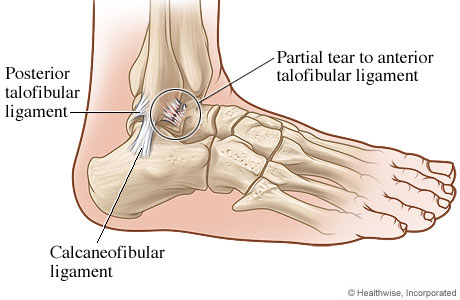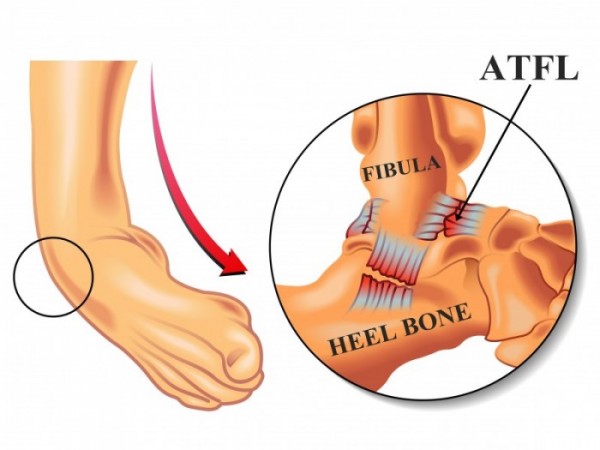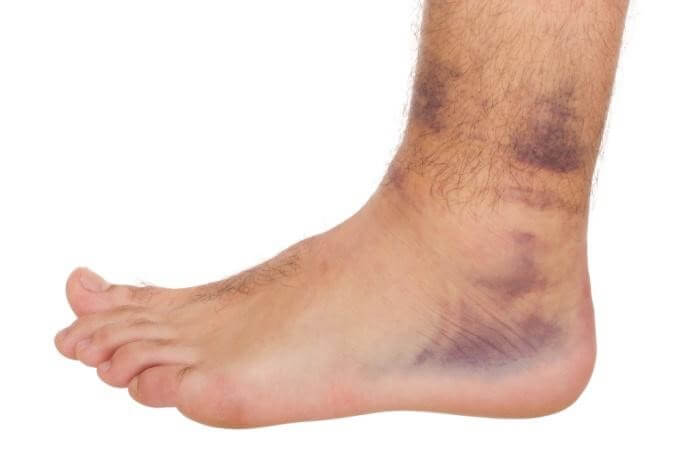Ankle Sprain Injuries are not harmless!!
Extracts taken from Assocaite Professor Eammon Delahunt in Sports Physio & GCPSH Sports & Olympic Phyiso, Britt Caling
 The lateral ligament complex of the ankle is usually defined as the ligaments shown in the photo consisting of the Anterior (towards the front) Talofibular ligament, the Calcaneofibular ligament (on the side) and the Posterior (towards the back of the ankle bone) Talofibular ligament.
The lateral ligament complex of the ankle is usually defined as the ligaments shown in the photo consisting of the Anterior (towards the front) Talofibular ligament, the Calcaneofibular ligament (on the side) and the Posterior (towards the back of the ankle bone) Talofibular ligament.
Sprain injury to these ligaments is the most prevalent injury sustained in both competitive and recreational sports activities. In Australia, up to 70% of the population have experienced a ligament sprain to these ankle ligaments, and they commonly occur in young athletes and adolescents and can significantly affect their ability to participate in sports and activity for long periods of time.

Lateral Ankle Sprains are acute injuries that usually occur when the foot ‘inverts’- that is, the bottom of the foot extremely faces inwards
These injuries usually occur with change of direction sports (think basketball, tennis, netball), in
collision sports (say when a tackler lands on your lower leg when your foot is planted) and sports with uneven surfaces such as trail running.
Signs and Symptoms
An acute episode will occur where often you are not sure exactly which way your foot or ankle went. The result is acute pain on the outside of your ankle and sometimes an inability to walk immediately. In some injuries, the pain settles enough the you can continue to jog or play with a little limp and a little pain, and in more severe injuries, you will be unable to put weight on your foot until later in the day due to pain. The swelling may create a sensation of stiffness.
Swelling and or bruising will appear on the outside of your ankle. In severe sprains, the swelling/bruising may track down to your foot and toes.
While acute symptoms may resolve relatively quickly and with minimal treatment, many people regards these injuries are “harmless”, however the reality is quite different. The pain and swelling and altered joint mechanics are big risk factors for the development of Chronic Ankle Instability (CAI).
The recurrence rate of ankle sprains is very high and this recurrence can result in the chronic presentation of on-going swelling, ankle joint ‘giving way’, symptoms of the joint being unstable and then further sprain episodes. This vicious cycle may continue for many month, or years. Up to 40% of people can be expected to develop CAI within one year of sustaining their first ligament sprain injury (Delahunt et al) which can significantly affect sport/activity participation, and also result in maladaptive patterns of use of the knee or hip and result in injury to these joints.
These injuries are definately NOT harmless!
Management of Ankle Sprains
On initial injury, try to control the swelling with ice-baths and compression (find an esky, add water and ice and do gradual ankle movements short of pain in the ice-bath for 5min at a time). Aim to walk normally on your ankle as soon as possible and as pain permits. Having said this, bone fracture in the lower leg bone (fibula), the foot or the toes can also present with a ligament sprain, so a thorough Physio assessment is warranted in the early phases- particularly if you are unable to walk (not necessarily normally, but with some capacity to weight-bear) within the first 2days.
Ideal is to present to Physio within the first 3days of injury with some early, regular treatment and monitoring helping to reduce your risk of further injury.
A Physio assessment will decide if Xray or other investigations are needed that would mean the treatment direction needs to differ, compared to if the injury is purely to the ligaments only.
All the Physio’s at Gold Coast Physio & Sports Health can thoroughly asses and manage your ankle injuries, and they can guide your return to sports or activity with the aim to prevent recurrence, or progression to CAI.
We can teach you taping techniques (this link will take you to the taping we use in our Trail Runners, and participants engaging in activities such as the Kokoda Challenge Gold Coast, click here), or organise a brace for you to use if warranted, and we can guide you on appropriate exercises to perform to reduce the likelihood of progressing to Chronic Ankle Instabilities.
For more information, ask our Frontdesk Team which of our Physio’s has a special interest in your sport and will be best suited to understand the demands of your training and competition and then help you achieve your sports or health goals. For Bookings, phone 07 5500 6470, or book online via our website homepage.
Happy Sporting Pursuits for now!
